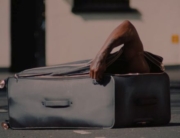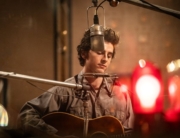
Initially, at the beginning of David Byrne’s career and particularly with his time in the Talking Heads, he came across as a convulsive neurotic, confused and overwhelmed by human relations, technology, and the relationship between the two. Today, Byrne is an elder statesman of rock, and American Utopia, the staged retrospective of his repertoire, shows off a much more relaxed, genial presence. His anxieties have mellowed toward curiosity and bemusement.
This filmed version of the Broadway show, staged and with choreography by Annie B-Parsons, is, in essence, a highly choreographed concert. Byrne and a group of 11 musicians perform 21 songs with occasional scripted introductions, audience interactions, and a ton of choreographed movement.
Of course, Byrne’s old band Talking Heads was the subject of Stop Making Sense, arguably the greatest concert film ever made. David Byrne’s American Utopia is not quite up to that level, simply because conceptually, Stop Making Sense seemed so new and fresh at the time, but nevertheless the new film is very, very good. Much of this can be credited to director Spike Lee, who seems to preternaturally know when to cut to a master shot of the stage and when to literally swoop in to catch wonderful moments, like the snap of fingers or a fleeting smile of one of the musicians. It’s so succinctly and seamlessly put together that the filmmaking adds resonance to the show’s theme, which is connection.
Byrne starts off by holding and examining a (fake) human brain and delivering a brief monologue about how babies have millions more neural connections than adults. As they begin to discover the world around them, they simply discard the connection they don’t need. This leads to the first song, “Here.”
The fascination with much of his music is how insular it is compared to the ebullience of his music. And I don’t mean insular in the sense of, say, Jackson Browne, who examines his feelings in minutia, but insular in the sense we are subject to Byrne’s fascination of literally living in his skin (there’s a song about it, “Glass, Concrete & Stone”) and his fascination with very particular subjects (as in the song that dissects the brain, “Here”).
Yet his music is open, expansive, and eminently danceable. His fascination, thankfully for us, includes rhythm. Out of his 11-person band, six are percussionists. This is a dance concert as much as anything else. Though Lee never focuses on the audience, you can see them getting down in the background in a serious manner.
The set itself is an empty stage, generously lit in white and pale blue. Everyone is dressed identically in pale gray suits, yet it feels less like they are wearing a uniform as part of a family, say a human family. The bare state is simply boxed in and surrounded by curtains of long thin chains. Sometimes the performers emerge through them, and in a particularly striking moment, only their hands are visible through the chains.
There’s uniformity to everything, including the robotic and rote choreography that feels vibrant, spontaneous, and alive. This exemplifies the heart of the show: using individuality to influence the collective to create change and inclusivity. In this case, David Byrne, the neurotic, bemused, ever curious individual, leads us into the collective.
After two hours of joyous, glorious music and through Byrne’s quixotic yet hopeful persona, you feel sated in the best hope for mankind in general and America in particular. Also, the performance of “Once in a Lifetime” is, and will forever be, the most scorching, ferocious, and strangely uplifting version you will ever see.
















Leave A Comment